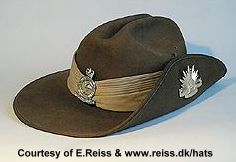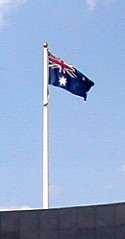| The
"slouch hat"
|
It is the name of that famous bush
hat with wide brims, one fold back on the left. It could have been draw
circum 1885 by Colonel Tom Price, first commander of the Victorian Mounted
Rifles. Originally, it was the right edge which was fold back to
the top. It allowed the soldiers to watch straight in the eyes of the officer
inspecting them as wanted by army rules. But from 1903, the left brim was
fold back in order rifles to be carry on the shoulder. The hat is made
of felt, rabbit fur transformed into a strong material. It affords an efficient
protection against sun and rain and is still in use in today Australian
army with the parade or town uniform - as the kepi in the French army.
During World War 2, some British soldiers used to wore it (in Burma) and
also the famous general Montgomery.
|
 Photo from
Photo from  The Rising Sun - 1904/1949 pattern
The Rising Sun - 1904/1949 pattern The Rising Sun - Today pattern
The Rising Sun - Today pattern

